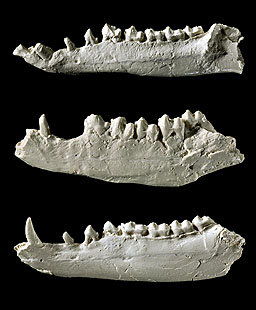Phil Gingerich
Big Little Big
At the start of the Eocene Epoch, about 55.5 million years ago, Earth experienced perhaps the most sudden and extreme warming at any time in its history. This planetary heatwave is called the Paleocene-Eocene Thermal Maximum, or PETM. Scientists, like Phil Gingerich at the University of Michigan, have found evidence that the PETM was associated with a major release of carbon dioxide into the environment, much as is happening with burning fossil fuels today. What we learn from studying the PETM may help us understand our own future.
The PETM had dramatic effects on plants and animals. Warmth-loving species migrated toward the poles, and some even extended their ranges across the Arctic to new continents. Some animals evolved smaller bodies. Fossil jaw bones show that a hoofed plant-eating mammal called Ectocion that lived in Wyoming was smaller (center) during the PETM than its relatives living before or after (bottom and top, respectively).

- Jaw bones found in Big Horn Basin, Wyoming. From the collection of P.D. Gingerich, University of Michigan.
- Ectocion osbornianus (top)
55.3 million years old - Ectocion parvus (center)
55.5 million years old - Ectocion osbornianus (bottom)
55.6 million years old - Illustration by Rebecca Horwitt © Smithsonian Institution.
Even today, mammals living in warm areas are smaller than their relatives from colder places, so the dwarfing of Ectocion is consistent with warming. Since the dwarfed Ectocion is smaller than expected from temperature change alone, the dwarfing may also reflect less protein in the plants the animal ate. Smithsonian scientist Bert Drake has shown that some plants grown in high levels of carbon dioxide have less protein in their leaves.
